The color brightness of the projector. What is it and why is it important?
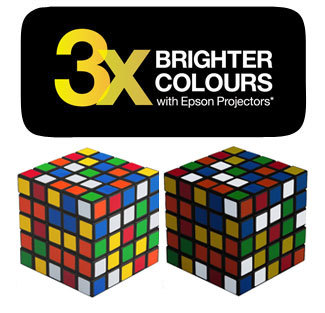 Perhaps you had to see statements earlier that Epson projectors have colors three times brighter ? In this post we will try to justify our position and draw your attention to such an important indicator of any projector, as "color brightness", which many do not even suspect when choosing a projector for home or office.
Perhaps you had to see statements earlier that Epson projectors have colors three times brighter ? In this post we will try to justify our position and draw your attention to such an important indicator of any projector, as "color brightness", which many do not even suspect when choosing a projector for home or office.Before talking about "color brightness", let's just touch just "brightness." And I propose to immediately clarify what is actually called “ luminous flux ” for simplicity as “projector brightness”. This parameter is measured in lumens and characterizes the amount of light that the projector is capable of emitting, its “power”.
Light flow
Many people know that the greater the luminous flux (brightness) of the projector, the larger the diagonal of the image can be obtained. In fact, you can get a large diagonal with absolutely any projector, however, no one can guarantee that the image will be acceptable in quality, color reproduction, and also quite clear and bright.
')
Consider the luminous flux of the projector in terms of image quality . Recall that each color can be described using only three characteristics, one of which is brightness . It is on this principle that many standards are used, including, in assessing the image quality of various devices.
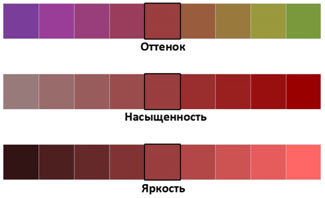
(We understand that it is incorrect to compare the brightness on the screen of a monitor from two different projectors, but in this case it is done for clarity.)
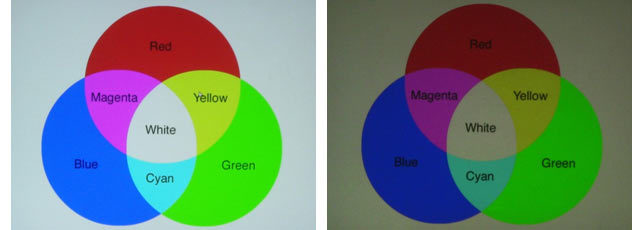
You do not need special knowledge to state that the right image is of lower quality, because instead of white it displays gray, instead of red it is dark red, etc. The image on the right is lower quality because the projector is not bright enough (for those conditions where it was received).
There are a number of other circumstances in which extra brightness is required from the projector to ensure acceptable image quality:
- when you need to use a more accurate color mode image;
- when viewing 3D;
- when economic lamp operation is used;
- when the projector is working in a lighted room.
This could put an end, if not for one problem:
Light flux and color brightness
The fact is that the luminous flux of the projector is traditionally determined by the white color . Considering that this parameter is one of the most important characteristics, recently manufacturers have begun to overestimate it, intensifying the white color displayed by the projector. Thus, images obtained from two projectors with the same luminous flux (brightness) may look as follows:
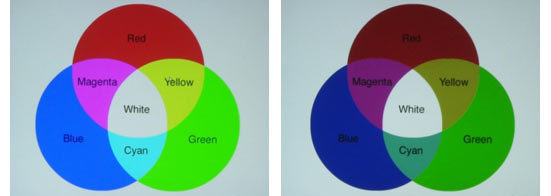
Indeed, in white color, their brightness (luminous flux) is the same, but the colors they convey in completely different ways.
In connection with this unusual circumstance, one more parameter was introduced into use: “ color brightness ”, or “ luminous flux by colors ” (English Color Light Output ). The color brightness consists of three components: the brightness (luminous flux) of the projector in red, in green and in blue.
In the images above, both projectors have the same brightness, however, on the left, the projector has a color brightness equal to “normal” brightness, and on the right, it is three times lower on the projector. We declare that in order for the projector to have the correct color, its brightness and color brightness must be equal. What does it follow from?
Color math
The fact is that most information display devices use the RGB principle (mixing red, green and blue) to form colors. Each pixel of an LCD monitor, for example, consists of red, green, and blue bars, with:
- when three dots glow with maximum brightness, it turns white;
- when with a minimum - black light is obtained;
- when red and green dots are lit up with maximum brightness, a yellow light is obtained;
- etc. etc.
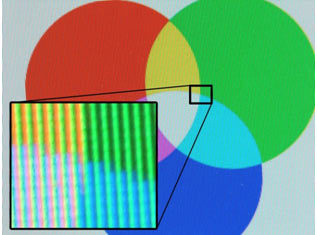
Let's return to " color brightness ". We said that the maximum brightness of the projector should be equal to the color brightness. In other words, if we measure the brightness on a white screen, then it should be equal to the sum of the brightness on the red, on the green screen and on the blue screen.
However, as we showed earlier, there are projectors in which this arithmetic does not work and the color brightness is up to three times lower than the maximum. And here we are confronted with the features of imaging technologies used in projectors!
Features of projector technology
The fact is that different technologies use light bulbs in different ways. Created by Epson, 3LCD technology uses three liquid crystal arrays to form an image. Thanks to the use of three matrices, the white light of the lamp is divided into a red, green and blue projector by means of special light filters, after which each stream passes through a separate matrix. These three components are then combined together, pixel to pixel, and a color image is projected on the screen. At the same time, all components are reproduced simultaneously and permanently.

This way of using the light of a lamp makes it possible to reduce the loss of light to a minimum, since in the 3LCD technology, thanks to three matrices, all three basic colors are used immediately.
If one projector were used in the projector rather than three, then at each time point we could work with only one color component out of three, and the rest would be filtered out, or simply “thrown away”. This would lead to huge losses of light, which could only be compensated by increasing the lamp power (which means that the projector would become more expensive and the noise level would increase due to the use of a more powerful cooling system).

I think this example clearly explains why there are so many projectors on the market that use various tricks with white gain. Due to the high efficiency of 3LCD technology, it is not easy to compete with it honestly.
The 3LCD technology forms colors in much the same way as other RGB devices, such as TV and monitor. Each projector using 3LCD technology has a maximum brightness equal to the color brightness , which ensures more accurate color reproduction. Epson always publishes a color brightness parameter for its projectors, while many are not willing to disclose this information for obvious reasons.
The site www.colorlightoutput.com/ru provides independent measurements of color brightness for a number of popular models of projectors based on other technologies. These measurements suggest that for many models the color brightness is three times lower than the maximum brightness, and therefore we say that three-matrix projectors based on 3LCD technology have up to three times brighter colors .
One of the advantages of the color brightness parameter is that it is easy to measure it yourself - all you need is a light meter and a tape measure.
Despite the fact that the parameter of color brightness is not announced by many manufacturers of projectors, it was accepted by representatives of the expert community. For example, the leading English-language website on projectors, Projectorcentral.com , included it in the specifications of all projectors, along with brightness and contrast.

Summarize
The color brightness of 3LCD projectors is always equal to their maximum brightness , which means a more accurate color reproduction. Such a projector guarantees good image quality even in the brightest mode of the projector - you can use every lumen!
This is especially important for projectors used in classrooms, meeting and training classes, because it allows you to get a beautiful image with vibrant colors on the big screen and even in a lighted room.
For home projectors, the correct color brightness is important because it is a prerequisite for the correct color rendition of movies, TV and video. Low color brightness obviously means a mistake in a color rendition.
Due to the fact that the color brightness is extremely easy to measure, this parameter is one of the most effective and affordable ways to get a general impression about the color rendition of the projector.
Finally, I would like to say that the 3LCD technology is the pride of Epson. The 3LCD logo on the projector has become for the buyer a kind of guarantee that this model has the correct color brightness and will please the user with a bright and balanced picture for many years!

Dear Habravchane,
Due to the fact that Habrahabr.ru was divided into three resources (HabraHabr, GeekTimes and MegaMozg), Epson's blog moved to Geektimes.ru .
Looking forward to seeing you on our GT blog!
Epson team
Source: https://habr.com/ru/post/222115/
All Articles